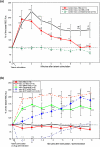Primary role of functional ischemia, quantitative evidence for the two-hit mechanism, and phosphodiesterase-5 inhibitor therapy in mouse muscular dystrophy
- PMID: 17726536
- PMCID: PMC1950086
- DOI: 10.1371/journal.pone.0000806
Primary role of functional ischemia, quantitative evidence for the two-hit mechanism, and phosphodiesterase-5 inhibitor therapy in mouse muscular dystrophy
Abstract
Background: Duchenne Muscular Dystrophy (DMD) is characterized by increased muscle damage and an abnormal blood flow after muscle contraction: the state of functional ischemia. Until now, however, the cause-effect relationship between the pathogenesis of DMD and functional ischemia was unclear. We examined (i) whether functional ischemia is necessary to cause contraction-induced myofiber damage and (ii) whether functional ischemia alone is sufficient to induce the damage.
Methodology/principal findings: In vivo microscopy was used to document assays developed to measure intramuscular red blood cell flux, to quantify the amount of vasodilatory molecules produced from myofibers, and to determine the extent of myofiber damage. Reversal of functional ischemia via pharmacological manipulation prevented contraction-induced myofiber damage in mdx mice, the murine equivalent of DMD. This result indicates that functional ischemia is required for, and thus an essential cause of, muscle damage in mdx mice. Next, to determine whether functional ischemia alone is enough to explain the disease, the extent of ischemia and the amount of myofiber damage were compared both in control and mdx mice. In control mice, functional ischemia alone was found insufficient to cause a similar degree of myofiber damage observed in mdx mice. Additional mechanisms are likely contributing to cause more severe myofiber damage in mdx mice, suggestive of the existence of a "two-hit" mechanism in the pathogenesis of this disease.
Conclusions/significance: Evidence was provided supporting the essential role of functional ischemia in contraction-induced myofiber damage in mdx mice. Furthermore, the first quantitative evidence for the "two-hit" mechanism in this disease was documented. Significantly, the vasoactive drug tadalafil, a phosphodiesterase 5 inhibitor, administered to mdx mice ameliorated muscle damage.
Conflict of interest statement
Figures








References
-
- Hoffman EP, Kunkel LM. Dystrophin abnormalities in Duchenne/Becker muscular dystrophy. Neuron. 1989;2:1019–1029. - PubMed
-
- Emery AE. Population frequencies of inherited neuromuscular diseases–a world survey. Neuromuscul Disord. 1991;1:19–29. - PubMed
-
- Petrof BJ. The molecular basis of activity-induced muscle injury in Duchenne muscular dystrophy. Mol Cell Biochem. 1998;179:111–123. - PubMed
Publication types
MeSH terms
Substances
Grants and funding
LinkOut - more resources
Full Text Sources
Other Literature Sources
Medical
Molecular Biology Databases

